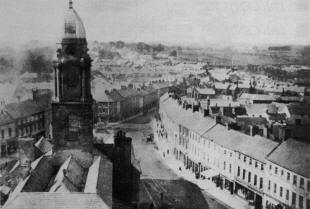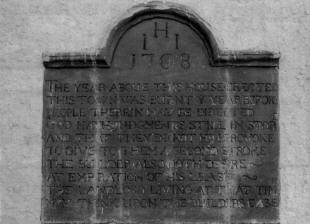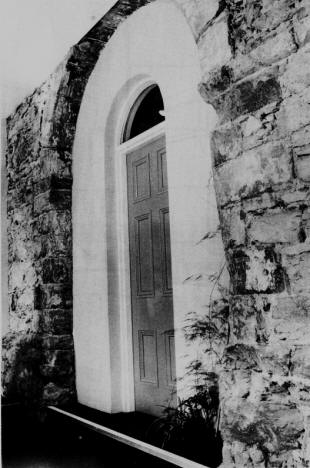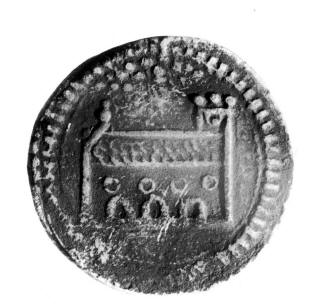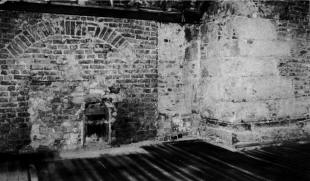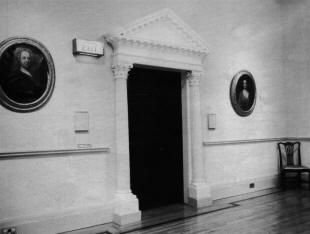
- Front Page
- Foreword
- Acknowledgements
- Contents
- Lisburn Seventeenth Century Tokens
- Mr. Stewart's Ballroom Near Lisburn:
- The Last Will And Testament Of Edward, 1St Viscount Conway And Killultagh (1564-1631)
- Chrome Hill, Lambeg
- The Early Christian Ringfort Of Lissue
- The Lisburn By-Election Of 21 February 1863
- The Market House And Assembly Rooms, Lisburn
- Bygone Days
- Historical Journals
THE MARKET HOUSE AND ASSEMBLY ROOMS, LISBURN
BRIAN MACKEY
 |
| Fig. 11. Lisburn Museum, from Castle Street. (Photograph Lisburn Museum, 1986). |
In 1980, the removal of plaster from the ground floor interior walls of the Assembly Rooms in Market Square, to prepare them for their new use as Lisburn Museum, led to the exciting discovery of substantial stone walls with red sandstone arches, plinth and plat band (fig. 1). The walls, three feet thick, belong to the old market house which, with three arches on north and south sides and one at the east end, is described in late 18th and early 19th century sources. 2
The market house was believed to date from the early 18th century, for Lisburn was rebuilt after a disastrous fire of 1707, and it was thought that the market house-like the cathedral across the street -was rebuilt in the following year.3 However, this assumption overlooked a contemporary description of the fire by the Rev. Alexander McCracken, Presbyterian minister in Lisburn, which states '... there is not a house standing except the Market House'. 4 This vital piece of evidence encouraged a comparison of the market house arches with another semi-circular archway in Lisburn which was built of the same red sandstone-the gateway in Castle Gardens. This was the entrance through the east courtyard wall of Lisburn castle, a 17th century manor house built by the Conways and also destroyed in the fire of 1707. The gateway, with its baroque ornamentation, is much more elaborate that the market house arches but is of importance because it is dated 1677. This dating proves that this local stone was used for building in 17th century Lisburn. Substantial structures were capable of surviving a fire which otherwise could entirely destroy a town consisting largely of timber framed buildings. The market house walls are therefore probably of the 17th century. The establishment of a more specific dating than this requires an examination of Lisburn's early market development.
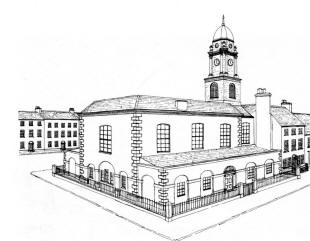 |
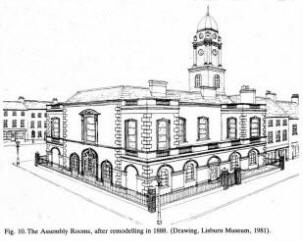 |
| Fig. 9. The market house, as it most likely appeared, after the additions of the early 19th century. (Drawing, Lisburn Museum, 1981). | Fig. 10. The Assembly Rooms, after remodelling in 1888. (Drawing, Lisburn Museum, 1981). |
Lisnagarvey was established in the second decade of the 17th century as the manorial headquarters of Sir Fulke Conway's newly acquired Killultagh estate.5 The first map of the town, 'the Grounde Plane of Lisnegarvey' (c. 1632), shows the street plan devised by Sir Fulke and gives an architectural outline of the manor house and first church.6 It only marks with a rectangle the building in the centre of Market Square, thereby giving no indication of its architectural character. It is labelled as the schoolhouse and is perhaps the place to which Lord Conway referred in 1629: 'The school is not yet too full of scholars for one man to manage even though he does the work of the church also' .7
In 1627, Charles I granted the right of a weekly market and two fairs in Lisburn to Sir Fulke's brother and successor, Edward, Viscount Conway and Killultagh.8 Tuesday was fixed as the market day (which it has remained) and the fairs were to begin on July 10th and September 24th and last for three days. The surviving Conway papers from these years show their concern to capitalise on this grant and to see a thriving market established, but do not refer to the building of a market house .9 Yet one had been erected by 1641, for it was referred to as being the scene of fierce fighting in the market place during the battle for Lisnagarvey, in the Irish rebellion of that year. 10 Nothing is known about its design or construction but it can be surmised that, if it still served as a school, it was a two storey building with a market area below and a schoolroom above.
However, the connection of the school to the market house in the market place, based on the first map, may be misleading, as there are no references to the two being together. Perhaps, when the first market house was built in the 1630s, the school was moved to another site. In the 1680s, 'the old schoolhouse' was in serious need of repair and there is nothing in the full discussion of its state and description of the improvements, to suggest that it also served as a market house.11 Indeed, in his consideration of the old school as a new free school for the diocese of Connor, it seems unlikely that Lord Conway would have agreed to settle the building and its site for further school development (as the act of Parliament required), if the school was in the centre of the market place. 12
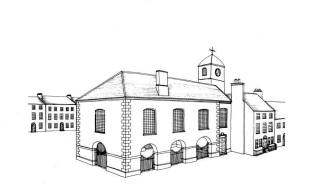 |
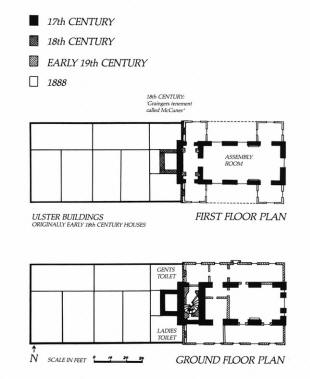 |
| Fig. 3. A conjectural reconstruction of the market house in the mid 18th century, as seen from Castle Street. (Drawing, Lisburn Museum, 1981). | Fig. 4. Plan of the former market house and Assembly Rooms, Market Square, now Lisburn Museum. (Lisburn Museum, 1986, see ref. 31). |
To return to the subject of the market, letters in 1666 to Lord Conway from Sit George Rawdon (his principal agent in Lisburn from 1631 to 1684) reveal that a Maurice Griffiths had had a lease of the market tolls and had built a market house at his own expense: 'As to the market I do not well remember if Maurice Griffiths lease be out or not, but that house was built wholly at his charge under which the people place their meal and many other things stand and wherein is More's most inconvenient shop'.13 (This 'More' is very likely the, Edward Moore who issued a Lisburn trade token in 1666).14 Unfortunately, no mention is made of how long this building had been erected and no other information can be found on Maurice Griffiths. He may have been dead by 1669, as his name does not appear in the Hearth Money Roll of that year.15 It could be that, if he had along lease ( the fact that Rawdon was unable to remember its details suggests this), he was the builder of the market house which was in existence by 1641. It is also possible that if that building was severely damaged in the bitter fighting which took place in and around it then, that Griffiths's market house replaced it sometime after that, in the more settled years of the Commonwealth or Charles II's restoration.
Whatever
the date of erection of Griffiths's building may be, the fact that it existed in
1666 almost certainly relates it to the fascinating representation of the market
house on the John Peers Lisburn trade token (fig. 2). It has been argued
convincingly that this token is not a conventional representation, but a
depiction of an actual building. Certainly, it seems- as has been indicated
16- that the line of semi-circles above the base line represent market
house arcading rather than church windows. Unfortunately, no evidence can be
found to show that Peers, like More, operated from the market house, though this
is most likely. In 1666, at the end of Griffiths's lease, stewardship of the
markets was given to John Totnall, a man of business in Lord Conway's service,
who sublet the collection of the market customs to William Stephens. 17
Rawdon reports on Stephen's death in 1677, explaining that Totnall had £30 a
year rent for him, £20 for himself and £10 for Lord Conway.18 Irish
trade tokens date between 1653 and 1679. The Peers token is not dated, but as it
is marked Lisburn rather than Lisnagarvey, it suggests a dating after 1662,
since the name Lisburn is not found commonly before then.19 Peers's
father was Vicar of Derriaghy in the 1630s and he may have been born in this
neighbouring parish.20
The Hearth Money Rolls of 1669, together with the evidence of his will, shows
that he was at least resident in Lisburn from then until his death in 1700.21
Even if he did not trade from the market house, he had a house in the market
place, so there seems little reason to doubt that what is represented is Lisburn
market house in the 1660s or 1670s. 22
![]()
The market house which Maurice Griffiths built, and for which John Peers seems to have provided such an important illustration, comes very close to the period in which it might reasonably be expected that evidence would be found for the building of the present market house. In 1674, Lord Conway paid £30 for the building of a market house in Warwick, near his English country house, Ragley Hall.23 Yet in the comparatively full correspondence of Rawdon to Conway, of these years, there is no mention of a new market house for Lisburn, even though there are many references to thriving market development.24 There was not only pride in the many fine houses being built by prospering townspeople but a desire by Rawdon to play his part in enhancing the town, by improving the accommodation of the markets. He wrote to Conway in 1677'... the hill is almost levelled where I intend to place the butchers stalls that encumber the street and market Place which will enlarge it for a corn market and make room to draw up a body of horse on occasion.25 The area set aside for the corn market was the triangle formed by the narrowing of the market place at its west end. 26 By 1680, Rawdon had accomplished his scheme. The butchers were moved to new accommodation in an area levelled for them, probably where Smithfield Square is today, '... the new shambles are very noble and have enlarged the market place, now the butchers blocks are removed, which were to be wished it could be made bigger, for there is need of it'.27 In 1683, Rawdon had the market place taken up and paved and proudly boasted it was the best in Ireland, but made no mention of the market house 28 Indeed the only reference to it in these years is in 1673 when Rawdon, explaining the effects of a harvest crisis and the expense of wheat in the market, declared '... want of the old market house, for my granary has been above £60 loss to Me'. 29 The brevity of this statement leaves it unclear as to whether the old market house, presumably that built by Griffiths, was still there or whether Rawdon was just unable to store grain in it because it was given over to another use.
In the apparent absence of any other information on the market house in the late 17th century, consideration has to be given to the remarkable possibility that the market house built by Maurice Griffiths, and standing in 1666, is that which survives today. Since it is thought the Griffiths building is that represented on the John Peers trade token, it seems reasonable to compare it with the surviving market house. The token shows a market house with three ground level arches and four first floor circular windows, which presumably are matched on its opposite side, and a bell tower rising above roof level at its front. As such, it is of similar basic design to the present market house, which also has three arches and four first floor windows (albeit much larger) on each of its long sides; and, as revealed in renovations to the adjoining houses in 1985, the abandoned base of an old tower. Having established therefore that both buildings are of the sane basic design, it is at least possible to believe that the representation on the Peers token is that of the present market house, whose walls and arches have survived despite the loss of its original tower, shingled roof, and baroque decoration. It is unfortunate that such an encouraging comparison has to be set within such an inconclusive historical framework, for the available evidence does not allow this fascinating conjecture to be proved one way or the other. All that can therefore be stated about the market house at the core of the museum building in Market Square, is that all available evidence points to its being a rare survival from the 17th century, and that an origin in the second quarter of the century cannot be dismissed.
Figure 3 is a reconstructed view of the market house in the 18th century, based on a survey of the building and on documentary evidence. Nothing is known of the appearance of the steeple, taken down in 1772, other than the fact it had a clock and bell. However, the base of a square tower (8' 6" square inside, rising to roof level) still survives in front of the present cupola. An account in 1814 explains '..this market house had a handsome steeple to it, with a clock and bell; but being decayed by length of time it was taken down about the year 1772, and rebuilt as high as the roof of the house in which state it remained about 30 years during the life of the late Marquis ...'s 30 (Francis Seymour-Conway, then 1st Earl of Hertford). The surviving tower base must therefore be that rebuilt in the 1770s, on the site of the old steeple and abandoned for the new larger base to the present cupola, erected in 1808. The old steeple projected from the front of the market house (fig. 4). 31 This position would have allowed the original roof to have had a higher central ridge, rather than the present lower triple ridge, which must have been constructed to accommodate the new cupola (fig. 5).
The west end or 'front' of the market house has been concealed by houses built up against it since at least the early 18th century. Jacob Hancock's mortgage of 1710 tells that he built a house in the middle of the market place. 32 His son John's lease of 1741 records that he (the elder Hancock) probably built all the property on the site '... 53 feet across the front, 82 feet backwards and 53 feet in breadth at the back, as houses next ajoined in the east to Graingers tenement called McClunes and in the west to the cornmarket' 33 The property 53 feet by 83 feet is now the Ulster Buildings. It has been so altered as to give no indication to its age, apart from the tablet of 1708 commemorating the building of a Lisburn house after the fire (fig. 6). The red sandstone plaque is now at the north west comer of the Ulster Buildings but an engraving of 1836 and old photographs reveal that it was formerly on the prominent west front 34 It was the Quaker Jacob Hancock who was `the builder' mentioned in its interesting inscription. 'Graingers tenement, called McClunes' is the property between what was Hancock's and the market house and whose ground floor is now used for public toilets. Its second floor was renovated for museum use in 1985 and its old red brick walls confirmed that it was of at least early 18th century date. It was also during this renovation that the front of the market house was exposed and shown to have been built of large blocks of cut red sandstone (fig. 7).
The
market house, as it was in the 18th century, was interestingly described in the
Ordnance Survey Memoir of 1837. 'Grain of every description meal and potatoes
were sold in the market square round the market house ... which was very
accommodating to the public as a shelter and stand for the above commodities,
had three large
arch
gates on either side and one at the cast end through which carts, cats etc.,
could pass on market days and it was also useful on other days in various
respects'.35 Much earlier, in 1778, the building achieved a certain
amount of national celebrity when an anonymous author had a description of
Lisburn published in a Dublin magazine: `At the junction of the three main
principal streets stands a handsome market house with an assembly room over it
fifty feet by twenty five in the clear and a drawing room twenty five feet by
twenty'.36 The assembly room of these dimensions still exists but the
drawing room is difficult to locate. There is nowhere else on the first floor
(in a building which measures 65 feet by 30 feet on the outside) for a separate
room to be. At this time, drawing rooms were often used by older people as
places for card games or relaxation during balls. It may have been above the
assembly room, in the attic of the original roof and have had dormer windows,
for in the light of existing information it seems the only place it could have
been. The assembly room is described in 1837: `on the upper storey is a
beautiful ballroom, ... well lighted by seven large windows and on the west
end
of it a very neat constructed orcaster, or gallery, for the music players to sit
on. Suspended from the ceiling are three handsome chandeliers besides other
accommodation for lighting the room. It is in all other respects well fitted and
affords two fireplaces'.37 Only a fine wooden doorcase with
Corinthian columns and pediment, dating from about 1750, survives from this
elegant era. It was subsequently altered, probably when the 'music players' dais
was removed in the 1888 remodelling of the building. This work entailed
extending the columns to the floor, by insetting fluted pieces three feet long,
and placing a fanlight between the rehung doors and the pediment. The classical
proportions, however, were restored in 1980, with the return of the doorway to
its correct height, by bringing down the original doorcase to the present floor
level (fig. 8).
![]()
The sardonic writer of 1778 reported `... here a genteel assembly is held every fortnight, and two great balls annually. The profits arising there from are applied to support the County Infirmary which is in this town.' The annual subscription was 'one guinea per year, and none but quality properly introduced, were admitted as subscribers'. The Lisburn `quality' were defined as 'gentlemen, clergy and linen drapers' by this writer, who, in the manner of Jane Austen, satirizes their character `... pride being their principal foible'. 'A lady of quality in this neighborhood came one evening to the head assembly in Lisburn, where none but quality are admitted; being asked her opinion of it, said it was a genteel mob. The ladies in Lisburn were offended, and really from a lady of the first rank in Ireland such an expression would be rude and unpolite: But why should not gentlemen and their ladies have as much license to despise linen drapers, as the latter those who follow other trades?� 38 as Other writers Were much kinder to Lisburn society. The romantic Henry Bayly. writing in 1834, when the balls in the market house had ceased, lamented their passing when he related: 'As the Lisburn ladies have long been proverbial for beauty, what a splendid and fashionable display must then have adorned the room! Will the days ever come, when the sound of the song and the dance shall make these walls to ring again!' 39
Dancing was certainly taken very seriously, for in 1785, the Belfast News Letter announced the opening of a dancing school every Friday and Saturday in the market house. The dancing master, Mr. McGrath, pointed out that he had just returned from Dublin and had collected all the fashionable dances. 40 Another ball in the assembly room was that held annually by the clergy of the diocese of Down and Connor, at the time of the Bishop's annual visitation. The charge was a half-crown, with the profits again supporting the Infirmary. 40 Dinners were also held. In 1780, the Irish Volunteer Company, the Lisburn True Blues, dined and entertained their officers in the room after mustering in the square. It must have been a colorful scene as they sat around the table in their blue coats, and cheered the speeches that extolled the Whig virtues of the Glorious Revolution and Liberty, and responded to the endless toasts which concluded all such dinners.42 In vivid contrast to these social uses were the occasions when John Wesley urged repentance and acceptance of new life on the sinners of the town. On his first of many visits to Lisburn between 1756 and 1789, Wesley preached in the building presumably in the assembly room. On the 22nd July 1756, he wrote in his journal: `We drove through heavy rain to Lisburn. I preached in the Market House at seven'. 43
An event more historic and tragic took place during the rebellion of 1798. Henry Munro, a Protestant linen draper, who led the United Irishmen at the Battle of Ballynahinch, was hanged in the market place, in front of his house. His head was severed from his body and stuck on a pike at the corner of the market house, where it remained for over a month, as a grim warning to others not to involve themselves in revolutionary activity.44 At this time, the market house arches were boarded up and the building used as `... a temporary barrack and stand for the cavalry and infantry occasionally'.45 It was the rebellion which incidentally brought about the first major changes to the market house, for it is said to have caused a rare visit to Lisburn by its landlord, then the 2nd Marquess of Hertford.46 He directed that additions be made to the building to improve its appearance and facilities. These were carried out in the first decade of the 19th century (fig. 9). The most notable was the building of the present imposing cupola by David McBlain and his son James. 47 They also designed the spire placed on the cathedral in 1804, thereby giving Lisburn its distinctive skyline. 48 Yet despite the fact that the 2nd Marquess initiated these works, which greatly enhanced the town's appearance, it was claimed he contributed only £750 to the erection of both buildings (£500 for the church steeple and £250 for the market house). If the spire cost £1,300, the cupola must have cost at least as much, if not more. A considerable sum had therefore to be met, by a tax on the town's inhabitants.49 By whatever means the money was raised, the cupola remains a distinguished architectural design, and recently merited the following description: `on a square of dressed free stone with a round headed window in each face stands a lesser square, with a clock face in each front, framed in paired Corinthian columns; each pair supports an entablature with a festooned urn; between these in the stone octagon there are open oels-de-boeuf; topped by a tall octagonal lantern and finial'.50
On the ground floor, the market house arches were closed up
and new accommodation was added. The addition on the south side, with its new
arcade of five arches, was separated
from the rest of the building and `occupied as stores for the market stalls for
the sale of butter, fowl, eggs and wool'.50
The entrance to the new rooms in the old market area was through the addition on
the north side. According to Henry Bayly, writing in 1834: `A gymnasium has
recently been fitted up in the lower part of the house, and a lending library
(under the care of Miss Magdeline Stewart) has the convenience of one of the
apartments52.
![]()
One of the most interesting institutions to occupy these new rooms was the Lisburn News Room Society: `Founded in the year 1836 by the shopkeepers and traders of Lisburn who agreed to close their shops at 9.00 p.m., and having nothing particular to do between that hour and bedtime decided to for a club ... providing a place in which the men of the town can assemble for either recreation or a quiet read.' Dean Stannus, Lord Hertford's agent, granted `... an apartment in the market house recently fitted up as a library and reading room'.53 This was the `... spacious well fitted news room which measures 35 feet by 22½ feet inside and is lighted by three windows' which still exists as the largest room on the ground floor. 54 (From 1889, this was known as the billiard room, as the News Room Society used it for table games until they ceased to meet in 1970). The Society resided in the building until political dissension forced them to withdraw to other premises. In the 1852 parliamentary election, the Marquess of Hertford's nominated candidate was a Mr. Inglis from Scotland but members of the News Room supported their own candidate, Mr. Roger Johnston-Smyth, who lived in Castle Street. The local candidate won by 99 votes to 87. As a result, Dr. McCartney, Secretary of the News Room, received the following letter: 'Dear Sir, Be so good as to notify to the meeting that the use of the news room will be discontinued on and after the 1st February next. Yours very truly James Stannus.' A Conservative News Room Society met in their place until 1889, when they were amalgamated, with Sir Richard Wallace's agreement that they could return to the building on a non-sectarian and non-political basis." In 1936, they held their centenary dinner in the assembly room, on a night still poignantly remembered by one present, as that of Edward VIII's abdication.56
In 1888, the market house (henceforth known as the Assembly Rooms) was remodelled and embellished in its present style (fig. 10). This added four rectangular towers to the first floor, with large arch headed windows matching those existing at that level, and provided a second stairway to the assembly room in the new south east corner. Since the building's market function was now ended, the five open arches on the south side were closed up by two pairs of double leaf doors with semi-circular fanlights and by three rounded headed windows. Uniformity of window style was achieved by changing the rest of the ground floor windows to this round-headed type. Balustrading, stucco mouldings and other ornamentation completed the new Italianate exterior which, it has recently been observed, `gave the building a full measure of three-dimensional strength which its important position undoubtedly merits'. 57 The remodelling, which included new illuminated clock dials and a bell for the cupola, cost Sir Richard Wallace £2,000.58 It was the last of his three main building projects in Lisburn and like the others, Castle House and the Courthouse, seems to have been directed by his estate surveyor John MacHenry.59 The works were well received, with the Lisburn Standard commenting that `... the result affords the clearest evidence of Sir Richard's desire to have the entire undertaking perfected in a style of the most approved modern workmanship and finish ... it is no merely hackneyed or formal compliment to say that this imposing fabric is now a real ornament to the town, and one that, while of diversified practical use as far as the inhabitants are concerned, is sure to be much admired by strangers who may happen to visit Lisburn'.60
In 1901, Sir John Murray Scott, heir of Lady Wallace, gave
the Assembly Rooms to Lisburn Urban District Council, for `the benefit of the
inhabitants of the town'.61 This century, new sovereigns and victory
in two World Wars were proclaimed from the balcony and the assembly room was
used for such civic functions as the annual Chamber of Commerce dinners and for
popular entertainment. 62 In 1979, Lisburn Borough Council gave the
building a new purpose by its decision to establish a museum serving the Lagan
Valley locality, a most fitting use considering the market house's remarkable
history. After major restoration and conversion work, the Lisburn Museum was
opened to the public in April 1981. The assembly room was reconstituted to
suggest its appearance in the 18th century, and in September 1985, reopened as a
space for temporary exhibitions and museum events. This work included a
reference library at the cast end of the room, on a new mezzanine balcony with
dental cornice supported by four Corinthian columns (the outside two of which
were salvaged from Lisburn Courthouse, built in 1884 and demolished in 1971). It
is the beginning of a new era for a historic building which for over three
hundred years has been at the heart of the life of the town (fig. 11).
![]()
REFERENCES
| 1 | The subject of this article was that of Lisburn Museum's opening exhibition in 1981, entitled `Market House, Assembly Rooms, Museum' and an information sheet of the same title, published in 1985. The author is grateful to the following who aided its research; Mr. C. E. B. Brett; Dr. W. H. Crawford; Mr. R. Heslip (especially for allowing a reading of 'Lisburn Seventeenth Century Tokens', now published in this journal); Mr. J. H. F. McCarrison; and Mr. T. Neill. A particular expression of thanks is given to Mr. H. Dixon, without whose constant advice and encouragement it could hardly have been written. |
| 2 | Walker's Hibernian Magazine, 1778, vol. 8, pp. 267-271; Ordnance Survey Memoirs, Blaris Parish, (1837) Royal Irish Academy, Box 5, Antrim V. |
| 3 | O.S. Memoir, Blaris, 5, V (13) p. 110; Lisburn Standard, 19 May 1888. |
| 4 | W.T. Latimer (ed.), 'the McCracken correspondence 1707-13', Royal Soc. of Annul. of Ireland Jn., 5th Ser., 1906, vol. 16, p. 52. |
| 5 | J.C. Erck (ed.), Patent Rolls of Chancery in Ireland, 1846, vol. 1 ii, pp. 594-595, for Sir Fulke Conway's patent of 1609. |
| 6 | Public Record Office of Northern Ireland (PRONI): T343/1. |
| 7 | Calendar of State Papers Ireland (CSPI) 1625-32, p. 497. |
| 8 | 1. Morrin (ed.), Calendar of the Patent and Close Rolls of Chancery in Ireland in the reign of Charles 1, 1883, p. 311. |
| 9 | CPSI, 1625-32, 1633-47. |
| 10 | 'History of the War of Ireland' by an officer of the regiment of Sir John Clotworthy in Rev, J. O'Laverty, Diocese of Down and Connor, 1880, vol. 2, p. 259. |
| 11 | Calendar of State Papers Domestic (CSPDJ 1683, pp. 55, 84-85, 123, 149. |
| 12 | 12. CSPD., 1679-80, p. 518. |
| 13 | CSPI, 166669, p. 55. |
| 14 | R. Heslip, 'Lisburn Seventeenth Century Tokens', this vol. |
| 15 | PRONI., T307, Hearth Money Roll, Co. Antrim (1669) Lisburn |
| 16 | CSPD., 1679-80, p. 518. |
| 17 | Heslip, op. cit. |
| 18 | CSPI, 1666-69, p. 95. |
| 19 | CSPD., 1676-77, p. 548. |
| 20 | Very Rev. W.P. Carmody, Lisburn Cathedral and its Past |
| 21 | 20. PRONI., T1289/9, Peers family genealogical notes. |
| 22 | Hearth Money Roll, op. cit.: PRONI., D2223/29/2 John Peers's will of 19 March 1700. |
| 23 | Registry of Deeds, Dublin, vol. 50, p. 10, memorial 31851. A mortgage of 1726 for 2 houses in the Market Place `(where the tenement formerly demised to John Peers stood)'. |
| 24 | CSPD, 1673-75, p. 321. |
| 25 | CSPD., vols. dealing with the period 1670-83. |
| 26 | CSPD., 1676-77, p. 576. |
| 27 | Lisburn Borough Council, Legal Register, document 1, a 1741 lease from Lord Conway to John Hancock for property in the middle of the market place which identifies the location of the corn market. |
| 28 | CSPD., 1680, p. 76. |
| 29 | CSPD., 1683, p. 249. An area of cobbling (approximately 10 ft. square) at the middle market house arch on the south side, was discovered when a wooden floor was removed in the 1980 renovations. It could hardly be described as paving and may have been even earlier than Rawdon's work in 1683. Regrettably the cobbles were taken up before their full significance was realized. |
| 30 | CSPD., 1673-75, p. 225. |
| 31 | (J Gough), A Tour of Ireland in 1813 and 1814 by an Englishman, 1817, p. 28. |
| 32 | Plan drawn from survey and - Lisburn B.C., Legal Reg., dust. 2, `Houses in Lisburn the property of Was. 1. Hancock ... 1836 ; PROM., O.S. 9/17/2, Ordnance Survey 1:500 town plan, Lisburn, sheet 7, 1861, revised in manuscript 1876. |
| 33 | Registry of Deeds, Dublin, vol. 10, p. 11, memorial 2938. |
| 34 | Lisburn B.C., Legal Reg., dot. 1, op. tit. |
| 35 | An engraving, titled erroneously, 'Lisburn Cathedral and Townhall', in Dublin Penny Journal, supplement to vol. 4; Nat. Lib. of Ire., Lawrence coll., C. 1778; Ulster Folk and Tran. Mus.. W.A. Green coll. 865. |
| 36 | O.S.M. Blaris, op. tit., 5, V (13) 84. Note that by the 1830s, what was called the Market Place since the early 17th century, had become known as Market Square. |
| 37 | Walker's, op. tit., p. 168. |
| 38 | O.S. Memoir Blaris, op. cit.. 5, V (13) p. 77. |
| 39 | Walker's, op. tit., pp. 168-270- |
| 40 | H. Bayly, A Topographical and Historical Account of List, ... ..., 1834, p. 41. |
| 41 | Belfast News Letter, 18 Feb. to 25 Feb. 1785. |
| 42 | (Gough), op. cit., p. 30. |
| 43 | Belfast News Letter, 11 April 1780. |
| 44 | G.E. Off, Lisburn Methodism, 1975, p. 9. |
| 45 | W.E.H. Lecky, History of Ireland in the Eighteenth Century. 1892, vol. 4, pp. 420-424; T.G.F. Paterson, 'Lisburn and Neighbourhood in 1798' in Ulster Journal of Archaeology, 3rd Set., 1938, vol. 1 ii, pp. 193-198. |
| 46 | O.S. Memoir Blaris, op. tit., 5, V (13) p. 84. |
| 47 | Ibid. |
| 48 | C.E.B. Brett, Court Houses and Marker Houses of the Province of Ulster, 1973, p. 33. |
| 49 | Carmody, op. cit., p. 60. |
| 50 | (Gough), op. cit., p. 27. |
| 51 | Brett, op. cit., p. 33. |
| 52 | O.S. Memoir Blaris, op. tit., 5, V (13) p. 77; Lisburn Museum collection, watercolours, by W.J. Boyle `Market Day, Market Sq., South, Lisburn, 1885' and the same subject by an amateur artist, c. 1880, show the function of this side of the market house. |
| 53 | Bayly, op. tit., p. 41. |
| 54 | Lisburn Standard, 18 Dec. 1936, p. 8, report on the News Room Centenary dinner, at which the speakers quoted extracts from the News Room's original minute book, which is now misplaced. |
| 55 | O. S. Memoir Blaris, op. cit., 5, V (13) p. 77. |
| 56 | Lisburn Standard, News Room centenary, op. cit. |
| 57 | By Mr. J. H. F. McCarrison, former editor of the Lisburn Herald and last President of the Lisburn News Room Society. At the centenary dinner, over a hundred members and guests subscribed their names to an illuminated scroll, intended as a permanent record of the occasion. It is now in the possession of Lisburn Historical Society. |
| 58 | H. Dixon, `So many Proofs'! Aspects of the legacy of 9r Richard Wallace in the fabric of Lisburn.', in Lisburn Hist. Soc., In., 1982, vol. 4. |
| 59 | Lisburn Standard, 19 May 1888. |
| 60 | Dixon, op. cit. |
| 61 | Lisburn Standard, 13 May 1888. |
| 62 | Lisburn B.C., Legal Reg., doc. 34. |
| 63 | Lisburn Museum photo. coll., 06.B/03, 'The Proclamation of Edward VII at the Assembly Rooms 1901' and,06.C/(19 & 10, `Chamber of Commerce Dinners in the Assembly Room 1930 and 1932' |
Brian Mackey had been Curator of Lisburn Museum since its inception in 1979 and has had responsibility for overseeing the building's restoration and adaptation to a local museum.

